Essay: Strategic Innovation and Competitiveness at Unilever (BUS3002)
VerifiedAdded on 2022/12/14
|9
|2298
|442
Essay
AI Summary
This essay critically evaluates Unilever's strategic approaches to managing innovation and creativity to achieve sustained competitiveness. It begins by outlining Unilever's competitive strategy, including cost leadership, differentiation, and focused strategies, and how they leverage these to gain a competitive advantage. The essay then explores Unilever's strategic approaches to innovation and creativity, including identifying new avenues for sustainable growth, bringing the best solutions to consumers, conducting research at world-class facilities, and focusing on innovation for people and the planet. The evaluation section delves into the challenges Unilever faced, such as changes in leadership and the adoption of new sustainability goals. The analysis examines the impact of innovative marketing strategies, job engagement, cultural and management changes, a long-term vision, and product development. The conclusion summarizes Unilever's commitment to sustainable innovation, connecting products to consumer lives, and meeting consumer needs. The essay provides a comprehensive overview of Unilever's strategic choices in innovation and competitiveness.
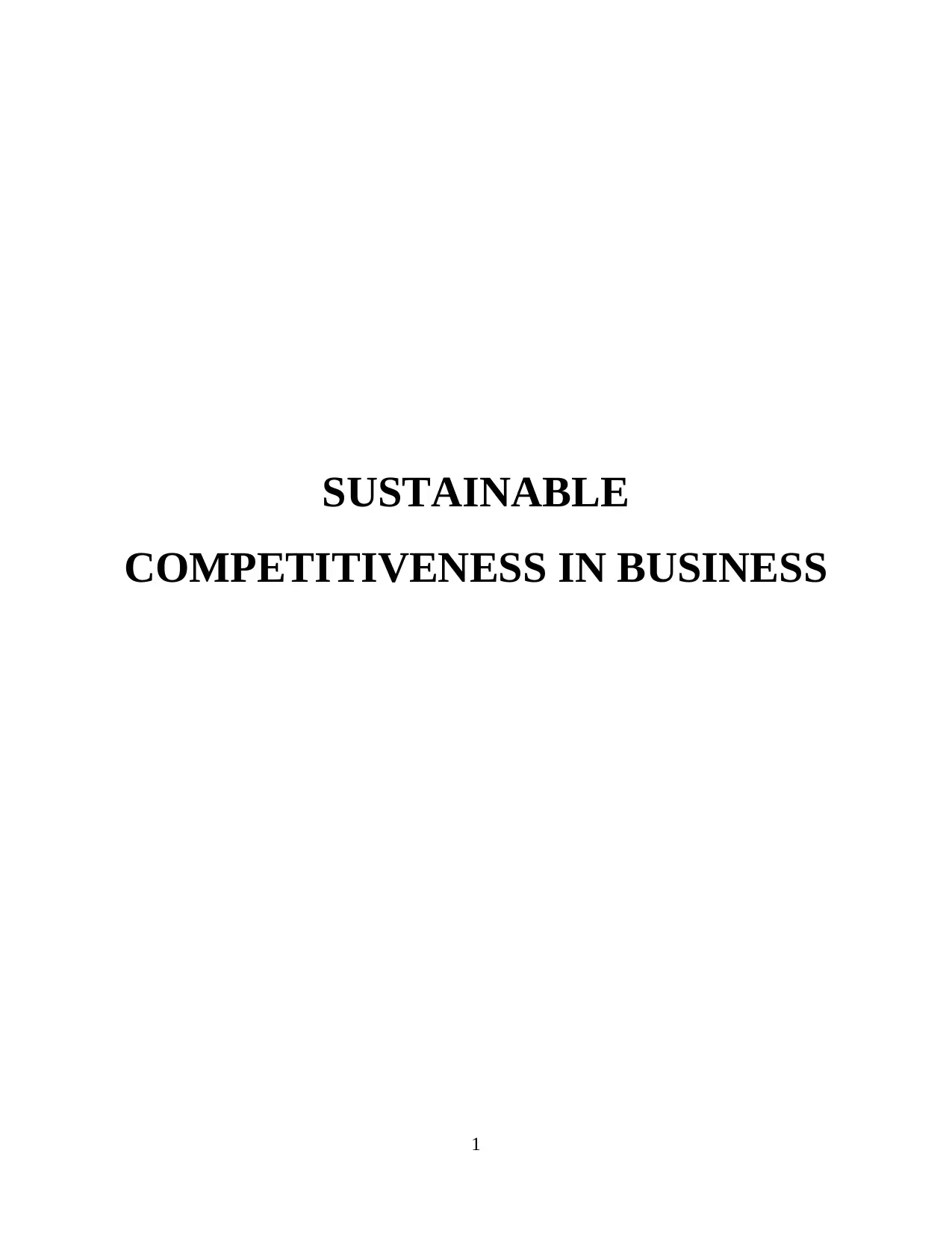
SUSTAINABLE
COMPETITIVENESS IN BUSINESS
1
COMPETITIVENESS IN BUSINESS
1
Paraphrase This Document
Need a fresh take? Get an instant paraphrase of this document with our AI Paraphraser
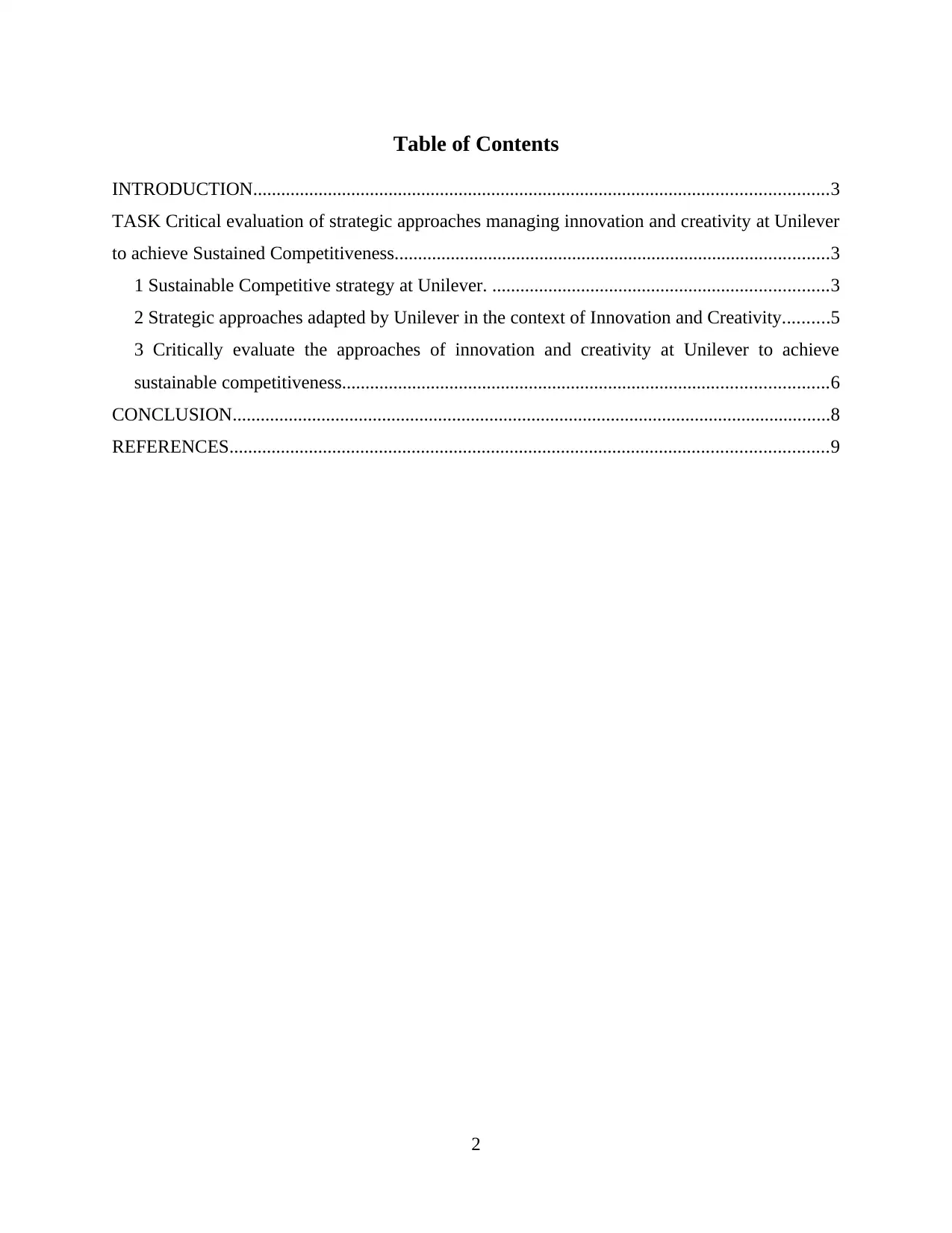
Table of Contents
INTRODUCTION...........................................................................................................................3
TASK Critical evaluation of strategic approaches managing innovation and creativity at Unilever
to achieve Sustained Competitiveness.............................................................................................3
1 Sustainable Competitive strategy at Unilever. ........................................................................3
2 Strategic approaches adapted by Unilever in the context of Innovation and Creativity..........5
3 Critically evaluate the approaches of innovation and creativity at Unilever to achieve
sustainable competitiveness........................................................................................................6
CONCLUSION................................................................................................................................8
REFERENCES................................................................................................................................9
2
INTRODUCTION...........................................................................................................................3
TASK Critical evaluation of strategic approaches managing innovation and creativity at Unilever
to achieve Sustained Competitiveness.............................................................................................3
1 Sustainable Competitive strategy at Unilever. ........................................................................3
2 Strategic approaches adapted by Unilever in the context of Innovation and Creativity..........5
3 Critically evaluate the approaches of innovation and creativity at Unilever to achieve
sustainable competitiveness........................................................................................................6
CONCLUSION................................................................................................................................8
REFERENCES................................................................................................................................9
2
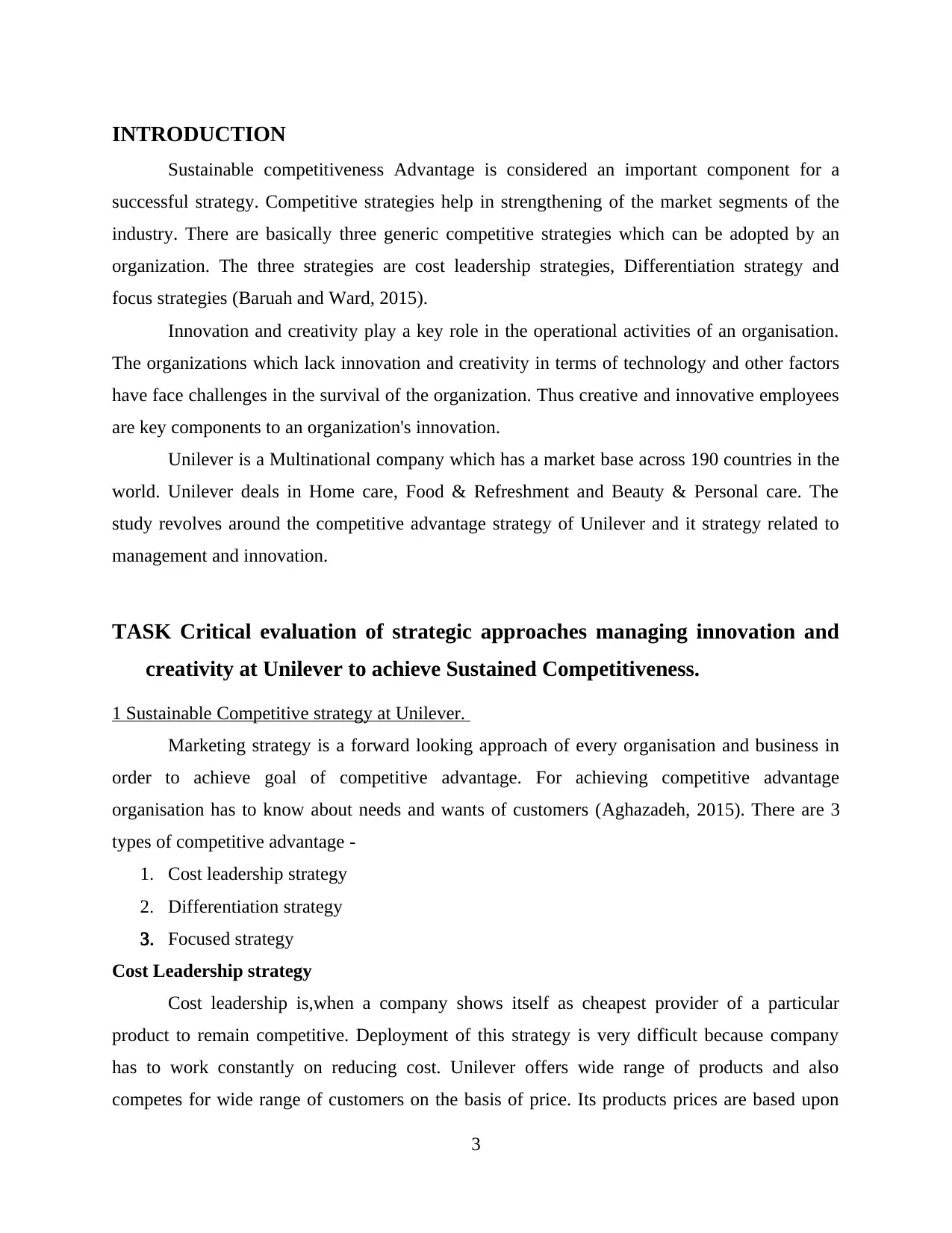
INTRODUCTION
Sustainable competitiveness Advantage is considered an important component for a
successful strategy. Competitive strategies help in strengthening of the market segments of the
industry. There are basically three generic competitive strategies which can be adopted by an
organization. The three strategies are cost leadership strategies, Differentiation strategy and
focus strategies (Baruah and Ward, 2015).
Innovation and creativity play a key role in the operational activities of an organisation.
The organizations which lack innovation and creativity in terms of technology and other factors
have face challenges in the survival of the organization. Thus creative and innovative employees
are key components to an organization's innovation.
Unilever is a Multinational company which has a market base across 190 countries in the
world. Unilever deals in Home care, Food & Refreshment and Beauty & Personal care. The
study revolves around the competitive advantage strategy of Unilever and it strategy related to
management and innovation.
TASK Critical evaluation of strategic approaches managing innovation and
creativity at Unilever to achieve Sustained Competitiveness.
1 Sustainable Competitive strategy at Unilever.
Marketing strategy is a forward looking approach of every organisation and business in
order to achieve goal of competitive advantage. For achieving competitive advantage
organisation has to know about needs and wants of customers (Aghazadeh, 2015). There are 3
types of competitive advantage -
1. Cost leadership strategy
2. Differentiation strategy
3. Focused strategy
Cost Leadership strategy
Cost leadership is,when a company shows itself as cheapest provider of a particular
product to remain competitive. Deployment of this strategy is very difficult because company
has to work constantly on reducing cost. Unilever offers wide range of products and also
competes for wide range of customers on the basis of price. Its products prices are based upon
3
Sustainable competitiveness Advantage is considered an important component for a
successful strategy. Competitive strategies help in strengthening of the market segments of the
industry. There are basically three generic competitive strategies which can be adopted by an
organization. The three strategies are cost leadership strategies, Differentiation strategy and
focus strategies (Baruah and Ward, 2015).
Innovation and creativity play a key role in the operational activities of an organisation.
The organizations which lack innovation and creativity in terms of technology and other factors
have face challenges in the survival of the organization. Thus creative and innovative employees
are key components to an organization's innovation.
Unilever is a Multinational company which has a market base across 190 countries in the
world. Unilever deals in Home care, Food & Refreshment and Beauty & Personal care. The
study revolves around the competitive advantage strategy of Unilever and it strategy related to
management and innovation.
TASK Critical evaluation of strategic approaches managing innovation and
creativity at Unilever to achieve Sustained Competitiveness.
1 Sustainable Competitive strategy at Unilever.
Marketing strategy is a forward looking approach of every organisation and business in
order to achieve goal of competitive advantage. For achieving competitive advantage
organisation has to know about needs and wants of customers (Aghazadeh, 2015). There are 3
types of competitive advantage -
1. Cost leadership strategy
2. Differentiation strategy
3. Focused strategy
Cost Leadership strategy
Cost leadership is,when a company shows itself as cheapest provider of a particular
product to remain competitive. Deployment of this strategy is very difficult because company
has to work constantly on reducing cost. Unilever offers wide range of products and also
competes for wide range of customers on the basis of price. Its products prices are based upon
3
⊘ This is a preview!⊘
Do you want full access?
Subscribe today to unlock all pages.

Trusted by 1+ million students worldwide
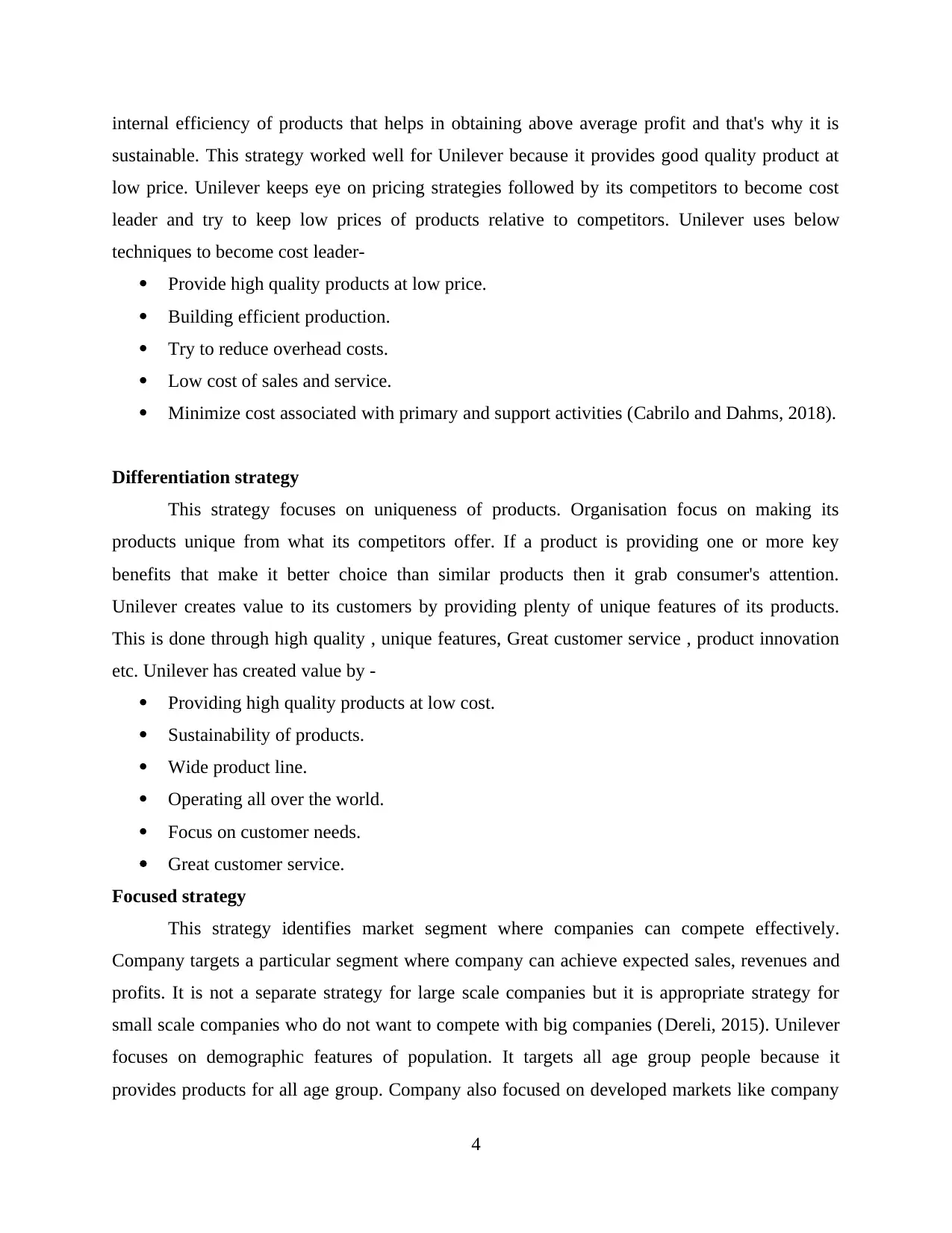
internal efficiency of products that helps in obtaining above average profit and that's why it is
sustainable. This strategy worked well for Unilever because it provides good quality product at
low price. Unilever keeps eye on pricing strategies followed by its competitors to become cost
leader and try to keep low prices of products relative to competitors. Unilever uses below
techniques to become cost leader-
Provide high quality products at low price.
Building efficient production.
Try to reduce overhead costs.
Low cost of sales and service.
Minimize cost associated with primary and support activities (Cabrilo and Dahms, 2018).
Differentiation strategy
This strategy focuses on uniqueness of products. Organisation focus on making its
products unique from what its competitors offer. If a product is providing one or more key
benefits that make it better choice than similar products then it grab consumer's attention.
Unilever creates value to its customers by providing plenty of unique features of its products.
This is done through high quality , unique features, Great customer service , product innovation
etc. Unilever has created value by -
Providing high quality products at low cost.
Sustainability of products.
Wide product line.
Operating all over the world.
Focus on customer needs.
Great customer service.
Focused strategy
This strategy identifies market segment where companies can compete effectively.
Company targets a particular segment where company can achieve expected sales, revenues and
profits. It is not a separate strategy for large scale companies but it is appropriate strategy for
small scale companies who do not want to compete with big companies (Dereli, 2015). Unilever
focuses on demographic features of population. It targets all age group people because it
provides products for all age group. Company also focused on developed markets like company
4
sustainable. This strategy worked well for Unilever because it provides good quality product at
low price. Unilever keeps eye on pricing strategies followed by its competitors to become cost
leader and try to keep low prices of products relative to competitors. Unilever uses below
techniques to become cost leader-
Provide high quality products at low price.
Building efficient production.
Try to reduce overhead costs.
Low cost of sales and service.
Minimize cost associated with primary and support activities (Cabrilo and Dahms, 2018).
Differentiation strategy
This strategy focuses on uniqueness of products. Organisation focus on making its
products unique from what its competitors offer. If a product is providing one or more key
benefits that make it better choice than similar products then it grab consumer's attention.
Unilever creates value to its customers by providing plenty of unique features of its products.
This is done through high quality , unique features, Great customer service , product innovation
etc. Unilever has created value by -
Providing high quality products at low cost.
Sustainability of products.
Wide product line.
Operating all over the world.
Focus on customer needs.
Great customer service.
Focused strategy
This strategy identifies market segment where companies can compete effectively.
Company targets a particular segment where company can achieve expected sales, revenues and
profits. It is not a separate strategy for large scale companies but it is appropriate strategy for
small scale companies who do not want to compete with big companies (Dereli, 2015). Unilever
focuses on demographic features of population. It targets all age group people because it
provides products for all age group. Company also focused on developed markets like company
4
Paraphrase This Document
Need a fresh take? Get an instant paraphrase of this document with our AI Paraphraser
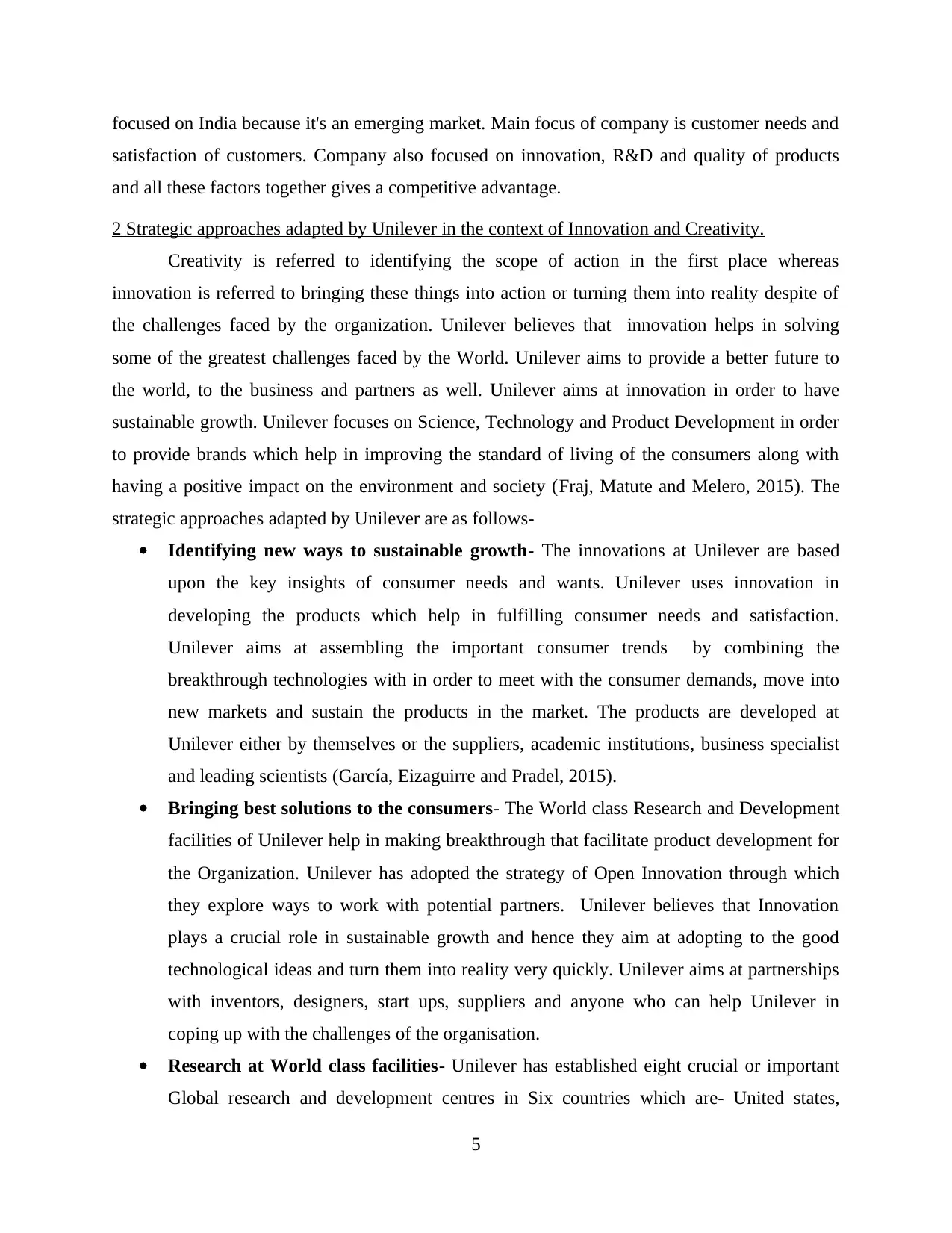
focused on India because it's an emerging market. Main focus of company is customer needs and
satisfaction of customers. Company also focused on innovation, R&D and quality of products
and all these factors together gives a competitive advantage.
2 Strategic approaches adapted by Unilever in the context of Innovation and Creativity.
Creativity is referred to identifying the scope of action in the first place whereas
innovation is referred to bringing these things into action or turning them into reality despite of
the challenges faced by the organization. Unilever believes that innovation helps in solving
some of the greatest challenges faced by the World. Unilever aims to provide a better future to
the world, to the business and partners as well. Unilever aims at innovation in order to have
sustainable growth. Unilever focuses on Science, Technology and Product Development in order
to provide brands which help in improving the standard of living of the consumers along with
having a positive impact on the environment and society (Fraj, Matute and Melero, 2015). The
strategic approaches adapted by Unilever are as follows-
Identifying new ways to sustainable growth- The innovations at Unilever are based
upon the key insights of consumer needs and wants. Unilever uses innovation in
developing the products which help in fulfilling consumer needs and satisfaction.
Unilever aims at assembling the important consumer trends by combining the
breakthrough technologies with in order to meet with the consumer demands, move into
new markets and sustain the products in the market. The products are developed at
Unilever either by themselves or the suppliers, academic institutions, business specialist
and leading scientists (García, Eizaguirre and Pradel, 2015).
Bringing best solutions to the consumers- The World class Research and Development
facilities of Unilever help in making breakthrough that facilitate product development for
the Organization. Unilever has adopted the strategy of Open Innovation through which
they explore ways to work with potential partners. Unilever believes that Innovation
plays a crucial role in sustainable growth and hence they aim at adopting to the good
technological ideas and turn them into reality very quickly. Unilever aims at partnerships
with inventors, designers, start ups, suppliers and anyone who can help Unilever in
coping up with the challenges of the organisation.
Research at World class facilities- Unilever has established eight crucial or important
Global research and development centres in Six countries which are- United states,
5
satisfaction of customers. Company also focused on innovation, R&D and quality of products
and all these factors together gives a competitive advantage.
2 Strategic approaches adapted by Unilever in the context of Innovation and Creativity.
Creativity is referred to identifying the scope of action in the first place whereas
innovation is referred to bringing these things into action or turning them into reality despite of
the challenges faced by the organization. Unilever believes that innovation helps in solving
some of the greatest challenges faced by the World. Unilever aims to provide a better future to
the world, to the business and partners as well. Unilever aims at innovation in order to have
sustainable growth. Unilever focuses on Science, Technology and Product Development in order
to provide brands which help in improving the standard of living of the consumers along with
having a positive impact on the environment and society (Fraj, Matute and Melero, 2015). The
strategic approaches adapted by Unilever are as follows-
Identifying new ways to sustainable growth- The innovations at Unilever are based
upon the key insights of consumer needs and wants. Unilever uses innovation in
developing the products which help in fulfilling consumer needs and satisfaction.
Unilever aims at assembling the important consumer trends by combining the
breakthrough technologies with in order to meet with the consumer demands, move into
new markets and sustain the products in the market. The products are developed at
Unilever either by themselves or the suppliers, academic institutions, business specialist
and leading scientists (García, Eizaguirre and Pradel, 2015).
Bringing best solutions to the consumers- The World class Research and Development
facilities of Unilever help in making breakthrough that facilitate product development for
the Organization. Unilever has adopted the strategy of Open Innovation through which
they explore ways to work with potential partners. Unilever believes that Innovation
plays a crucial role in sustainable growth and hence they aim at adopting to the good
technological ideas and turn them into reality very quickly. Unilever aims at partnerships
with inventors, designers, start ups, suppliers and anyone who can help Unilever in
coping up with the challenges of the organisation.
Research at World class facilities- Unilever has established eight crucial or important
Global research and development centres in Six countries which are- United states,
5
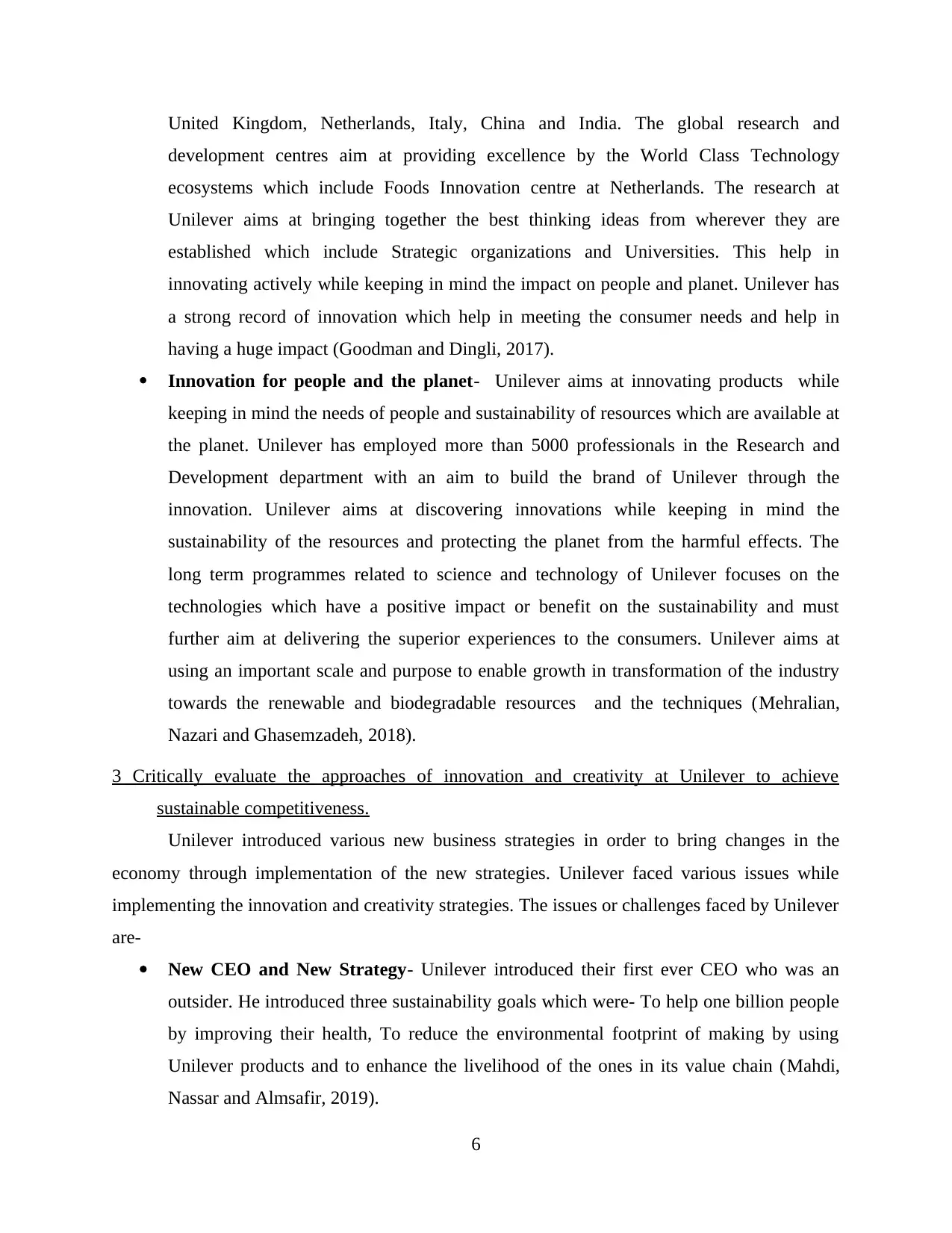
United Kingdom, Netherlands, Italy, China and India. The global research and
development centres aim at providing excellence by the World Class Technology
ecosystems which include Foods Innovation centre at Netherlands. The research at
Unilever aims at bringing together the best thinking ideas from wherever they are
established which include Strategic organizations and Universities. This help in
innovating actively while keeping in mind the impact on people and planet. Unilever has
a strong record of innovation which help in meeting the consumer needs and help in
having a huge impact (Goodman and Dingli, 2017).
Innovation for people and the planet- Unilever aims at innovating products while
keeping in mind the needs of people and sustainability of resources which are available at
the planet. Unilever has employed more than 5000 professionals in the Research and
Development department with an aim to build the brand of Unilever through the
innovation. Unilever aims at discovering innovations while keeping in mind the
sustainability of the resources and protecting the planet from the harmful effects. The
long term programmes related to science and technology of Unilever focuses on the
technologies which have a positive impact or benefit on the sustainability and must
further aim at delivering the superior experiences to the consumers. Unilever aims at
using an important scale and purpose to enable growth in transformation of the industry
towards the renewable and biodegradable resources and the techniques (Mehralian,
Nazari and Ghasemzadeh, 2018).
3 Critically evaluate the approaches of innovation and creativity at Unilever to achieve
sustainable competitiveness.
Unilever introduced various new business strategies in order to bring changes in the
economy through implementation of the new strategies. Unilever faced various issues while
implementing the innovation and creativity strategies. The issues or challenges faced by Unilever
are-
New CEO and New Strategy- Unilever introduced their first ever CEO who was an
outsider. He introduced three sustainability goals which were- To help one billion people
by improving their health, To reduce the environmental footprint of making by using
Unilever products and to enhance the livelihood of the ones in its value chain (Mahdi,
Nassar and Almsafir, 2019).
6
development centres aim at providing excellence by the World Class Technology
ecosystems which include Foods Innovation centre at Netherlands. The research at
Unilever aims at bringing together the best thinking ideas from wherever they are
established which include Strategic organizations and Universities. This help in
innovating actively while keeping in mind the impact on people and planet. Unilever has
a strong record of innovation which help in meeting the consumer needs and help in
having a huge impact (Goodman and Dingli, 2017).
Innovation for people and the planet- Unilever aims at innovating products while
keeping in mind the needs of people and sustainability of resources which are available at
the planet. Unilever has employed more than 5000 professionals in the Research and
Development department with an aim to build the brand of Unilever through the
innovation. Unilever aims at discovering innovations while keeping in mind the
sustainability of the resources and protecting the planet from the harmful effects. The
long term programmes related to science and technology of Unilever focuses on the
technologies which have a positive impact or benefit on the sustainability and must
further aim at delivering the superior experiences to the consumers. Unilever aims at
using an important scale and purpose to enable growth in transformation of the industry
towards the renewable and biodegradable resources and the techniques (Mehralian,
Nazari and Ghasemzadeh, 2018).
3 Critically evaluate the approaches of innovation and creativity at Unilever to achieve
sustainable competitiveness.
Unilever introduced various new business strategies in order to bring changes in the
economy through implementation of the new strategies. Unilever faced various issues while
implementing the innovation and creativity strategies. The issues or challenges faced by Unilever
are-
New CEO and New Strategy- Unilever introduced their first ever CEO who was an
outsider. He introduced three sustainability goals which were- To help one billion people
by improving their health, To reduce the environmental footprint of making by using
Unilever products and to enhance the livelihood of the ones in its value chain (Mahdi,
Nassar and Almsafir, 2019).
6
⊘ This is a preview!⊘
Do you want full access?
Subscribe today to unlock all pages.

Trusted by 1+ million students worldwide
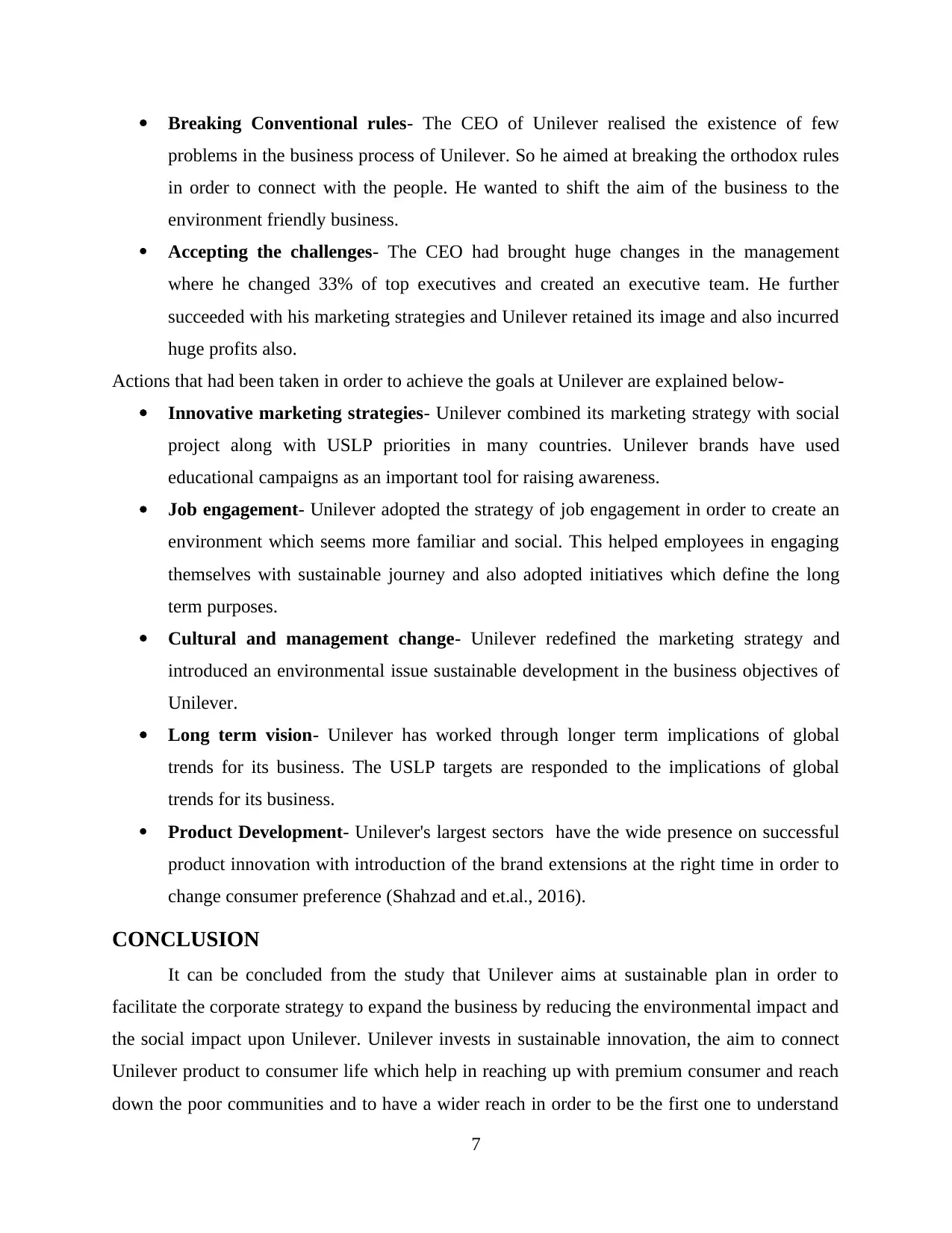
Breaking Conventional rules- The CEO of Unilever realised the existence of few
problems in the business process of Unilever. So he aimed at breaking the orthodox rules
in order to connect with the people. He wanted to shift the aim of the business to the
environment friendly business.
Accepting the challenges- The CEO had brought huge changes in the management
where he changed 33% of top executives and created an executive team. He further
succeeded with his marketing strategies and Unilever retained its image and also incurred
huge profits also.
Actions that had been taken in order to achieve the goals at Unilever are explained below-
Innovative marketing strategies- Unilever combined its marketing strategy with social
project along with USLP priorities in many countries. Unilever brands have used
educational campaigns as an important tool for raising awareness.
Job engagement- Unilever adopted the strategy of job engagement in order to create an
environment which seems more familiar and social. This helped employees in engaging
themselves with sustainable journey and also adopted initiatives which define the long
term purposes.
Cultural and management change- Unilever redefined the marketing strategy and
introduced an environmental issue sustainable development in the business objectives of
Unilever.
Long term vision- Unilever has worked through longer term implications of global
trends for its business. The USLP targets are responded to the implications of global
trends for its business.
Product Development- Unilever's largest sectors have the wide presence on successful
product innovation with introduction of the brand extensions at the right time in order to
change consumer preference (Shahzad and et.al., 2016).
CONCLUSION
It can be concluded from the study that Unilever aims at sustainable plan in order to
facilitate the corporate strategy to expand the business by reducing the environmental impact and
the social impact upon Unilever. Unilever invests in sustainable innovation, the aim to connect
Unilever product to consumer life which help in reaching up with premium consumer and reach
down the poor communities and to have a wider reach in order to be the first one to understand
7
problems in the business process of Unilever. So he aimed at breaking the orthodox rules
in order to connect with the people. He wanted to shift the aim of the business to the
environment friendly business.
Accepting the challenges- The CEO had brought huge changes in the management
where he changed 33% of top executives and created an executive team. He further
succeeded with his marketing strategies and Unilever retained its image and also incurred
huge profits also.
Actions that had been taken in order to achieve the goals at Unilever are explained below-
Innovative marketing strategies- Unilever combined its marketing strategy with social
project along with USLP priorities in many countries. Unilever brands have used
educational campaigns as an important tool for raising awareness.
Job engagement- Unilever adopted the strategy of job engagement in order to create an
environment which seems more familiar and social. This helped employees in engaging
themselves with sustainable journey and also adopted initiatives which define the long
term purposes.
Cultural and management change- Unilever redefined the marketing strategy and
introduced an environmental issue sustainable development in the business objectives of
Unilever.
Long term vision- Unilever has worked through longer term implications of global
trends for its business. The USLP targets are responded to the implications of global
trends for its business.
Product Development- Unilever's largest sectors have the wide presence on successful
product innovation with introduction of the brand extensions at the right time in order to
change consumer preference (Shahzad and et.al., 2016).
CONCLUSION
It can be concluded from the study that Unilever aims at sustainable plan in order to
facilitate the corporate strategy to expand the business by reducing the environmental impact and
the social impact upon Unilever. Unilever invests in sustainable innovation, the aim to connect
Unilever product to consumer life which help in reaching up with premium consumer and reach
down the poor communities and to have a wider reach in order to be the first one to understand
7
Paraphrase This Document
Need a fresh take? Get an instant paraphrase of this document with our AI Paraphraser
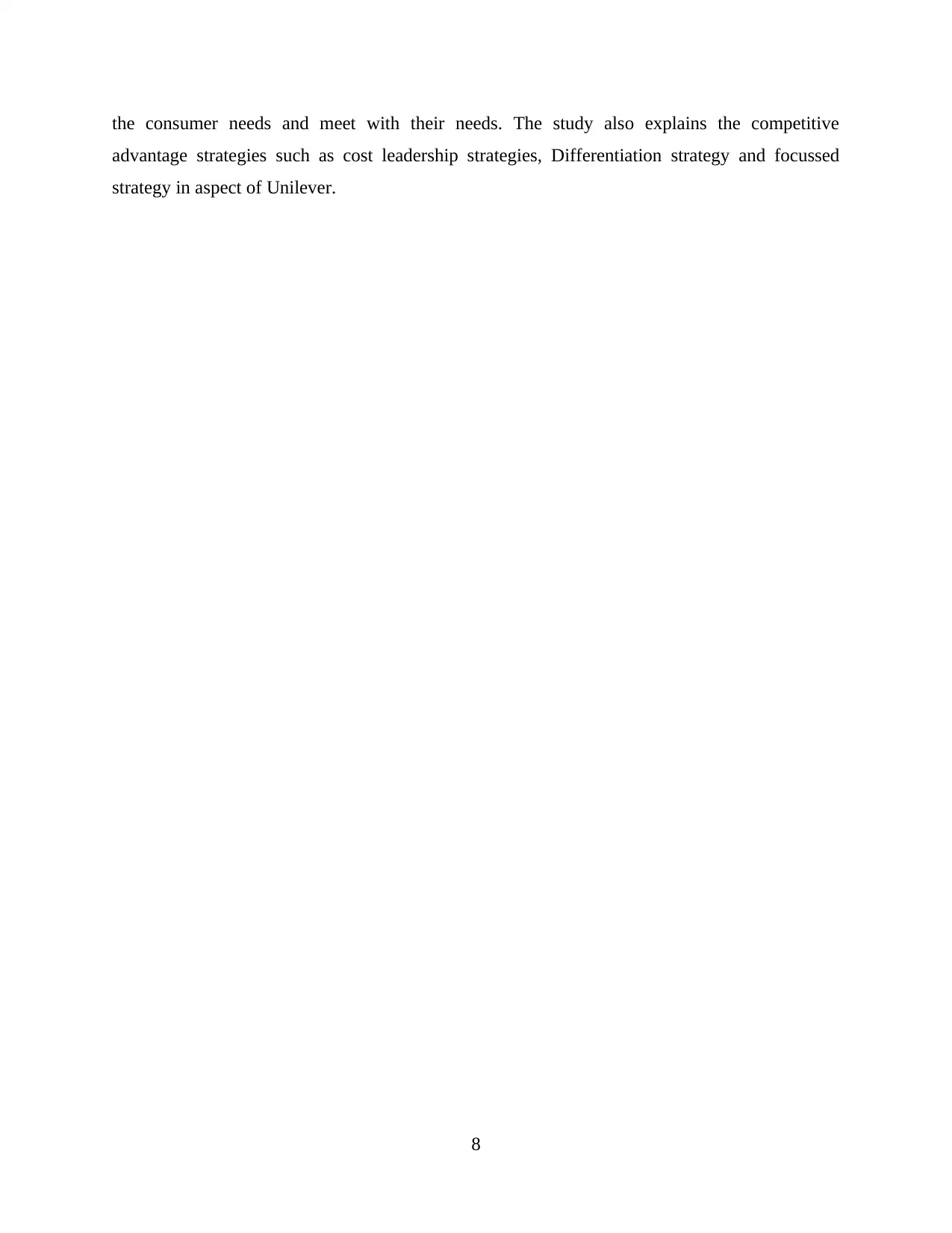
the consumer needs and meet with their needs. The study also explains the competitive
advantage strategies such as cost leadership strategies, Differentiation strategy and focussed
strategy in aspect of Unilever.
8
advantage strategies such as cost leadership strategies, Differentiation strategy and focussed
strategy in aspect of Unilever.
8
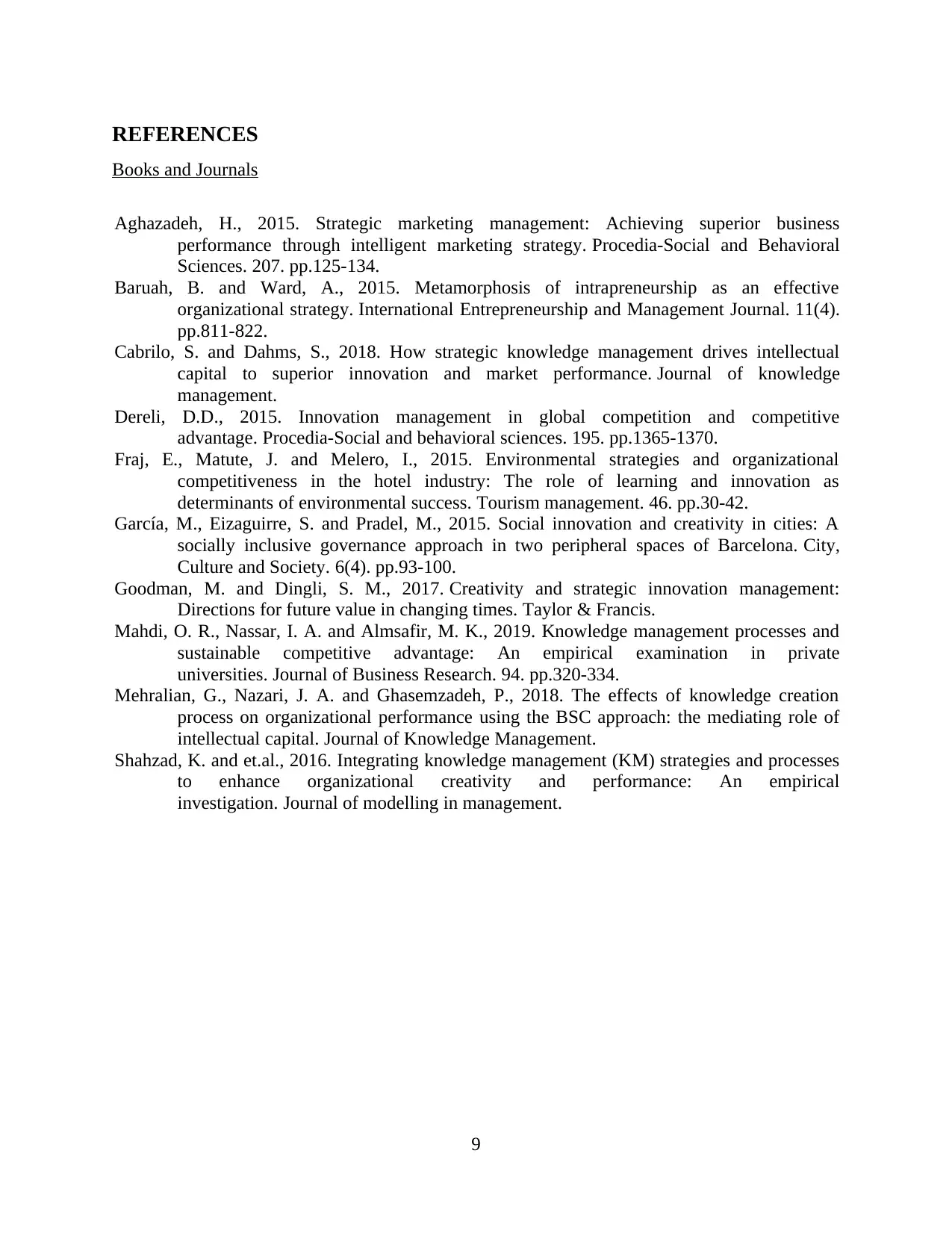
REFERENCES
Books and Journals
Aghazadeh, H., 2015. Strategic marketing management: Achieving superior business
performance through intelligent marketing strategy. Procedia-Social and Behavioral
Sciences. 207. pp.125-134.
Baruah, B. and Ward, A., 2015. Metamorphosis of intrapreneurship as an effective
organizational strategy. International Entrepreneurship and Management Journal. 11(4).
pp.811-822.
Cabrilo, S. and Dahms, S., 2018. How strategic knowledge management drives intellectual
capital to superior innovation and market performance. Journal of knowledge
management.
Dereli, D.D., 2015. Innovation management in global competition and competitive
advantage. Procedia-Social and behavioral sciences. 195. pp.1365-1370.
Fraj, E., Matute, J. and Melero, I., 2015. Environmental strategies and organizational
competitiveness in the hotel industry: The role of learning and innovation as
determinants of environmental success. Tourism management. 46. pp.30-42.
García, M., Eizaguirre, S. and Pradel, M., 2015. Social innovation and creativity in cities: A
socially inclusive governance approach in two peripheral spaces of Barcelona. City,
Culture and Society. 6(4). pp.93-100.
Goodman, M. and Dingli, S. M., 2017. Creativity and strategic innovation management:
Directions for future value in changing times. Taylor & Francis.
Mahdi, O. R., Nassar, I. A. and Almsafir, M. K., 2019. Knowledge management processes and
sustainable competitive advantage: An empirical examination in private
universities. Journal of Business Research. 94. pp.320-334.
Mehralian, G., Nazari, J. A. and Ghasemzadeh, P., 2018. The effects of knowledge creation
process on organizational performance using the BSC approach: the mediating role of
intellectual capital. Journal of Knowledge Management.
Shahzad, K. and et.al., 2016. Integrating knowledge management (KM) strategies and processes
to enhance organizational creativity and performance: An empirical
investigation. Journal of modelling in management.
9
Books and Journals
Aghazadeh, H., 2015. Strategic marketing management: Achieving superior business
performance through intelligent marketing strategy. Procedia-Social and Behavioral
Sciences. 207. pp.125-134.
Baruah, B. and Ward, A., 2015. Metamorphosis of intrapreneurship as an effective
organizational strategy. International Entrepreneurship and Management Journal. 11(4).
pp.811-822.
Cabrilo, S. and Dahms, S., 2018. How strategic knowledge management drives intellectual
capital to superior innovation and market performance. Journal of knowledge
management.
Dereli, D.D., 2015. Innovation management in global competition and competitive
advantage. Procedia-Social and behavioral sciences. 195. pp.1365-1370.
Fraj, E., Matute, J. and Melero, I., 2015. Environmental strategies and organizational
competitiveness in the hotel industry: The role of learning and innovation as
determinants of environmental success. Tourism management. 46. pp.30-42.
García, M., Eizaguirre, S. and Pradel, M., 2015. Social innovation and creativity in cities: A
socially inclusive governance approach in two peripheral spaces of Barcelona. City,
Culture and Society. 6(4). pp.93-100.
Goodman, M. and Dingli, S. M., 2017. Creativity and strategic innovation management:
Directions for future value in changing times. Taylor & Francis.
Mahdi, O. R., Nassar, I. A. and Almsafir, M. K., 2019. Knowledge management processes and
sustainable competitive advantage: An empirical examination in private
universities. Journal of Business Research. 94. pp.320-334.
Mehralian, G., Nazari, J. A. and Ghasemzadeh, P., 2018. The effects of knowledge creation
process on organizational performance using the BSC approach: the mediating role of
intellectual capital. Journal of Knowledge Management.
Shahzad, K. and et.al., 2016. Integrating knowledge management (KM) strategies and processes
to enhance organizational creativity and performance: An empirical
investigation. Journal of modelling in management.
9
⊘ This is a preview!⊘
Do you want full access?
Subscribe today to unlock all pages.

Trusted by 1+ million students worldwide
1 out of 9
Related Documents
Your All-in-One AI-Powered Toolkit for Academic Success.
+13062052269
info@desklib.com
Available 24*7 on WhatsApp / Email
![[object Object]](/_next/static/media/star-bottom.7253800d.svg)
Unlock your academic potential
Copyright © 2020–2025 A2Z Services. All Rights Reserved. Developed and managed by ZUCOL.





